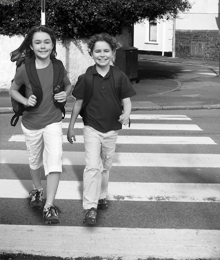Pedestrian Deaths in the GTA
April 5, 2010 by Madeline Stephenson
Filed under lifestyle
 Thousands of thoughts scatter through our minds as we scurry from one place to the next – from the bank to the bus stop, from the parking meter to a meeting, from the curb to the cab across the street. We carelessly cascade from work to play with a ticking clock beating in the back of our heads, perhaps forgetting to remember that one tiny slip in a driver’s judgement or a pedestrian’s alertness can lead to a catastrophe. We jeer at the concept of a nine-to-five life, wishing that minimalist expression actually rang some slight tone of truth. Wondering where the time went, the pedestrian puts an extra hop in her step as the driver gently steps on the gas. What’s an extra 10 kilometres, anyway? With every motion that we make, we guide our own fate. It takes just one second for lives to be turned upside down. Does the thought of safely crossing the street even cross your mind? What role does right-of-way really play?
Thousands of thoughts scatter through our minds as we scurry from one place to the next – from the bank to the bus stop, from the parking meter to a meeting, from the curb to the cab across the street. We carelessly cascade from work to play with a ticking clock beating in the back of our heads, perhaps forgetting to remember that one tiny slip in a driver’s judgement or a pedestrian’s alertness can lead to a catastrophe. We jeer at the concept of a nine-to-five life, wishing that minimalist expression actually rang some slight tone of truth. Wondering where the time went, the pedestrian puts an extra hop in her step as the driver gently steps on the gas. What’s an extra 10 kilometres, anyway? With every motion that we make, we guide our own fate. It takes just one second for lives to be turned upside down. Does the thought of safely crossing the street even cross your mind? What role does right-of-way really play?
In the Greater Toronto Area, 19 pedestrians have died this year – a disturbingly substantial increase from last year. Fourteen of those deaths occurred just in the month of January. While fingers are being pointed and causes are being questioned, it’s difficult to ignore the senselessness of such tragedies. “As adults we often get caught up in our lives and we don’t take that extra precaution … there is no common denominator other than speed and human error,” says Sgt. Tim Burrows of Toronto Traffic Services. January alone accounted for seven of the city of Toronto’s nine fatalities, which represents nearly a 100 per cent leap from 2009 figures. While police are extremely alarmed, they are identifying this number as a spike, as there are too few consistencies to concisely connect the dots. They all occurred at different times of the day, at different locations, and in different environments. The word ‘coincidence’ doesn’t seem to cut it in a society that is demanding answers, but drastic discrepancies of variables like these make it difficult to deliver a single explanation. “I was very concerned to read about the rise in pedestrian fatalities this winter,” says Ontario’s Minister of Transportation, Kathleen Wynne. “I know that we don’t have the definitive answer on the reasons for this increase, but I want to emphasize that all drivers and pedestrians need to be aware of each other at all times.”
Nouhad-Nicholas Al-Kassouf was one of the unlucky seven who died in a one-week pedestrian fatality wave in January. The 80-year-old woman was hit by a car around 1 p.m. on Jan. 12, 2010, while crossing Dundas Street West. According to police reports, a car travelling southbound through a green light struck both Al-Kassouf and another pedestrian. Al-Kassouf was one of four pedestrians killed or seriously injured in the GTA on that same day. Marites Mendoza, a 28-year-old mother, was killed while pushing a stroller across Martin Grove Road in Etobicoke. Her baby survived. The driver who hit Mendoza was charged with failing to stop at a red light and careless driving. A few hours earlier, while on his way to St. Joan of Arc Catholic High School in Vaughan, 17-year-old Steven Seixeiro was hit by a semi-trailer turning right at Rutherford Road and Keele Street.
His tragic death triggered the same shock that shook Vaughan in February 2009, when 16-year-old student Rose Mandarino was killed on her way home from school. Her twin brother watched as she was struck on a sidewalk by on oncoming SUV that was involved in a collision at Langstaff and Ansley Grove roads. “Just about every collision on the roadway is 100 per cent predictable and 100 per cent preventable,” says Burrows. Brian Patterson of Ontario Safety League agrees. “One of those intersections will have 10,000 cars a year minimum that go through without difficulty, so the fact that it occurred when they were there … human error is the universal element that we see.”
“Just about every collision on the roadway is 100 per cent predictable and 100 per cent preventable.”
– Tim Burrows, Toronto Traffic Services
While the onus for pedestrian fatalities is often a two-way street, determining who had the right-of-way can seem like a trivial pursuit when it’s already too late. “Right-of-way is a terrible issue if it’s being made from a hospital bed,” says Burrows, who actively reiterates this during public education lectures. “Road safety is a shared responsibility, everybody has to do their part.” Burrows puts the blame for many of the accidents he sees on a general lack of situational awareness from both parties.
Road safety enforcers have seen an entitlement trend in which the individual with the right-of-way feels invincible. This stops pedestrians from looking both ways before crossing the street and drivers from shielding the break pad while passing through a green light. “Use those few extra seconds to make a smarter choice. You may have the right-of-way, but you could end up being dead right,” says Joanne Banfield of iNavigait, a program that aims to reduce pedestrian injury and death. “The light may indicate that you can cross, but if you haven’t made eye contact and you’re not sure that a diver has seen you, the human body is no match for sheet metal and steel.”
In addition to managing the Trauma Injury Prevention program at Sunnybrook Hospital, Banfield has personally borne witness to the devastation of pedestrian distraction. “I once saw someone running for the bus. They were only looking in the direction of where the bus was coming from and not at the traffic; they ended up dying from their injuries,” she says. “There will always be another bus, but there will never be another you.” Banfield’s passion for prevention is prolific, but one of the most trying facets of her job is being fully aware that these situations are avoidable. “It’s tragic. We know it doesn’t need to happen, and for those of us that work in this field – doctors, nurses, the whole medical team – it’s very frustrating.” Burrows agrees, which is why he makes it his mission to drive these issues home. “If everybody decides ‘I’m going to be safer today, I’m going to pay attention, whether I’m a driver, or a cyclist or a pedestrian,’ we’re going to have safer roads,” he says.
“Use those few extra seconds to make a smarter choice. You may have the right-of-way, but you could end up being dead right.”
– Joanne Banfield, iNavigait
Achieving a mutual win-win situation may seem like a long dark road, but if people start paying better attention, they might realize that the light at the end of the tunnel is actually to their right. “Safety is not a revolution, it’s an evolution. I think sometimes we’ve got to go back to our core principles and the training and retraining of drivers is key,” says Patterson, adding that it may take a bit of time before the effects of Ontario’s new distracted driving law fully come to life. Bill 118 makes it illegal for drivers to text, talk, dial, type or e-mail using hand-held devices. Ontario’s transportation minister has high hopes that the legislation will lower the number of fatalities. “Studies show that drivers who use cellphones are four times more likely to get into a collision. We hope that the new law sends a clear message to all road users that distractions are dangerous and must be avoided,” says Wynne. While Burrows stands by the benefits of the bill, he thinks that the issue is more about the distraction than the device. “As much as I fully support and agree with the legislation, I think we have to look at the factors, it’s not just the device, it’s truly the distraction,” he says, adding that if driving behaviours don’t change, a next step might need to be taken.
There is also the burning question of whether streets are built for cars or people – especially in suburban areas where sidewalks and pedestrian signals are sometimes scarce or nonexistent. Some suggest that a brighter streetlamp should be shone on issues of city infrastructure and the opportunities to improve road conditions. Are new and confusing intersections contributing to the cause? Are all roads designed with pedestrians in mind? As congestion increases, so does competition for space. Although infrastructure can be viewed as a possible perpetrator, there is a seeming consensus that situational awareness is a key combatant that every individual must impose.
“We hope that the new law sends a clear message to all road users that distractions are dangerous and must be avoided.”
– Kathleen Wynne, Ontario’s minister of transportation.
Road improvements and Bill 118 may or may not be the weapons that obliterate roadway tragedies. The message, however, is clear: if society doesn’t start looking out for one another, we will only be pointing a gun at ourselves. Burrows cautions all drivers to, “Give themselves more time and recognize our population. Slow down, be aware and ready for the mistakes of others, and be alert. Scan, identify and protect.” With seniors accounting for the largest component of both injuries and fatalities, patience and increased awareness is even more vital. An elderly person may not be able to cross the street before the pedestrian sign waves its red hand. As for those on foot, “Stop, look and listen.” Take your hood off, take your ear buds out, and pay attention to what’s going on around you at all times. Eye contact is key.
Death is never the intended destination. What’s worse than a life lost is the realization that, with a little more precaution, it could have been preserved. The tow-truck driver could have turned his head. The cyclist could have slowed down. The woman could have waited for the next bus. We’ve all had these moments. What’s judgment without its rifts? It’s tough to consistently colour inside the lines when so many pictures are running through our heads. So who is accountable? “It can be a pedestrian, it can be a driver or it can be both,” says Banfield, “but I’m not willing to put my life on the line for that.” While human error might be human nature, our fatal flaw should not be negligence.
www.osl.org
www.mto.gov.on.ca
www.inavigait.com
www.educationforthedrivingmasses.com











Thank you so much for giving such an open view of the consequences that we witness in our daily lives. RIght of way is not something that should be assumed, it has to be available to take.